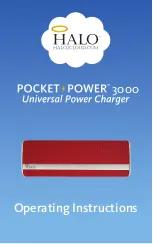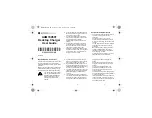
Operation
To make sure that a rechargeable battery still works faultlessly after a longer period of
time (without memory effect), it is recommended only to connect discharged rechargeable
batteries in the case of NiCd rechargeable batteries. Furthermore rechargeable batteries
should be discharged/charged once a month (self-discharge, loss of capacity).
1. Connect the charger to a mains outlet (230 V/AC, 50 Hz).
2. Insert the battery pack into the charger - the control LED lights up as long as the battery pack is connected
to the plug battery charger.
BEC
Tamiya
Plug
Socket
Plug
Socket
3. The charge current is not automatically disconnected. To avoid overloading and destruction of the battery
pack it is absolutely necessary to stop the charging process when the prescribed charge time (see table)
Number of cells (volt)
Charge time per 100 mAh
4 (4.8 V)
20 min
5 (6 V)
30 min
6 (7.2 V)
40 min
7 (8.4 V)
50 min
8 (9.6 V)
60 min
Determining charge time
Find the charge time per 100 mAh battery capacity for the relevant number of cells as given in the charge
timetable and multiply this number by the capacity of the battery pack.
Example:
6-cell battery pack (7.2 V) with 1000 mAh
Charge time for each 100 mAh acc. to table = 40 min
10 x 40 min = 400 min = 6 h 40 min charge time
The charger does not feature automatic switching-off. When the determined time of charging has
reached, the charger needs to be separated from the mains first and then from the battery pack.
Maintenance and cleaning
Do not use carbon-containing cleaning agents, petrol, alcohols or similar agents. This
can attack the surface of the charger. The fumes are furthermore a health hazard and
explosive. Moreover, you should not use sharp-edged tools, screwdrivers or metal bru-
shes or similar for cleaning.
Direct contact with water and humidity is to be strictly avoided! Operation is only permitted in dry and closed
areas. A dry lint-free cloth is recommended to use for cleaning the housing; use of cleaning agents should
be strictly avoided.
Disposal
a) General
Used electronic devices are raw materials and must not be disposed of in the domestic waste.
When the device has reached the end of its service life, please dispose of it according to the
current statutory requirements at your local collecting site. Disposal in the domestic waste
is not permitted!
b) Batteries and rechargeable batteries
You as end user are under legal obligation (Battery Regulation) to take back all used batteries
and rechargeable batteries. Disposing of them in the domestic waste is not permitted.
Batteries/storage batteries containing harmful substances are marked with the following sym-
bols, which point out that disposal in the domestic waste is prohibited. The designations for
the relevant heavy metals are the following: Cd = cadmium, Hg = mercury, Pb = lead. You can
return used batteries/rechargeable batteries free of charge to any collecting point in your local
authority, to our stores or to any other store where batteries/rechargeable batteries are sold.
In this way you comply with the legal obligations and make your contribution to environmental protection.
Technical Data
Operating voltage: 230 V/AC, 50 Hz
Connection:
Tamiya plug + BEC socket
Cable length: 100 mm
Number of cells:
4
5
6
7
8
Charging voltage:
5.6 V
7 V
8.4 V
9.8 V
11.2 V
Charging current: approx. 140 mA approx. 135 mA approx. 130 mA approx. 125 mA approx. 120
mA
Operating Instructions
PLUG-TYPE BATTERY CHARGER FOR POWER
PACKS
Item No. 2143156
Intended use
The charger is intended to charge 4- to 8-cell NiCd and NiMH battery packs (4.8 – 9.6 V) with Tamiya connec-
tion / BEC connection.
For safety and approval purposes, you must not rebuild and/or modify this product. If you use the product for
purposes other than those described above, the product may be damaged. In addition, improper use can result
in short circuits, fires, electric shocks or other hazards. Read the instructions carefully and store them in a safe
place. Make this product available to third parties only together with its operating instructions.
This product complies with the statutory national and European requirements. All company names and product
names are trademarks of their respective owners. All rights reserved.
Delivery content
• Charger
• Cable
• Operating instructions
Up-to-date Operating Instructions
Download the latest operating instructions at www.conrad.com/downloads or scan the
QR code shown. Follow the instructions on the website.
Safety Instructions
We do not assume liability for resulting damages to property or personal injury if the
product has been abused in any way or damaged by improper use or failure to observe
these operating instructions. The warranty/ guarantee will then expire!
The icon with exclamation mark indicates important information in the operating in-
structions. Carefully read the whole operating instructions before operating the device,
otherwise there is risk of danger.
a) Persons / Product
• The product is not a toy and should be kept out of
reach of children!
• The device must only be operated at 230 V/AC,
50 Hz.
• Strictly observe the charge times and technical
data in the operating instructions. Non-adherence
to these instructions causes damage to the de-
vice or the battery pack.
• Only NiCd and NiMH battery packs may be
charged with the device.
• The charger’s structure complies with safety
class II (double insulation). Make sure the insu-
lation (of the housing and/or the output line) is
neither damaged nor destroyed.
• Transmitting devices (radio-telephones, transmit-
ting installations for model constructions etc.)
must be kept away from the charger, since the
incident transmitting radiant emission could lead
to interference of the charging process and/or the
destruction of the charger and therefore also the
rechargeable batteries.
• In schools, training facilities and hobby work-
shops, operation of the product is to be super-
vised by trained, responsible personnel.
• In commercial institutions the accident prevention
regulations of the commercial trade organization
for electric installations must be strictly observed.
• In the case of improper handling (too high charg-
ing currents or wrong polarisation) the recharge-
able battery might be overloaded or destroyed.
In worst case the rechargeable battery might
explode and can cause substantial damage.
• The charger should be disconnected from mains
supply and the battery pack after use.
• The charger must not be covered with newspa-
pers, books or similar, to avoid possible damages
(due to heat generated during charging).
• When used in conjunction with other devices,
observe the operating instructions and safety
notices of connected devices.
• The product must not be subjected to heavy me-
chanical stress.
• The product must not be exposed it to extreme
temperatures, direct sunlight, intense vibration,
or dampness.
• If there is reason to believe that safe operation is
no longer possible, the device is to be put out of
operation and secured against unintended opera-
tion. Safe operation is no longer possible if the
device:
-
shows visible damages,
-
no longer works,
-
was stored under unfavourable conditions for
a long period of time or
-
was subject to considerable transport stress
b) Rechargeable batteries
• Correct polarity must be observed while connect-
ing the battery packs.
• Battery packs should be removed from the device
if it is not used for a long period of time to avoid
damage through leaking. Leaking or damaged
batteries might cause acid burns when in contact
with skin, therefore use suitable protective gloves
to handle corrupted batteries.
• Battery packs must be kept out of reach of chil-
dren. Do not leave the battery packs lying around,
as there is risk, that children or pets swallow it.
• Battery packs must not be dismantled, short-cir-
cuited or thrown into fire. Never recharge non-re-
chargeable batteries. There is a risk of explosion!
c) Miscellaneous
• Repair works must only be carried out by a spe-
cialist/ specialist workshop.
• If you have questions which remain unanswered
by these operating instructions, contact our tech-
nical support service or other technical personnel.
This is a publication by Conrad Electronic SE, Klaus-Conrad-Str. 1, D-92240 Hirschau (www.conrad.com). All rights in-
cluding translation reserved. Reproduction by any method, e.g. photocopy, microfilming, or the capture in electronic data
processing systems require the prior written approval by the editor. Reprinting, also in part, is prohibited. This publication
represents the technical status at the time of printing.
Copyright 2019 by Conrad Electronic SE.
*2143156_v1_0719_02_dh_m_en






















